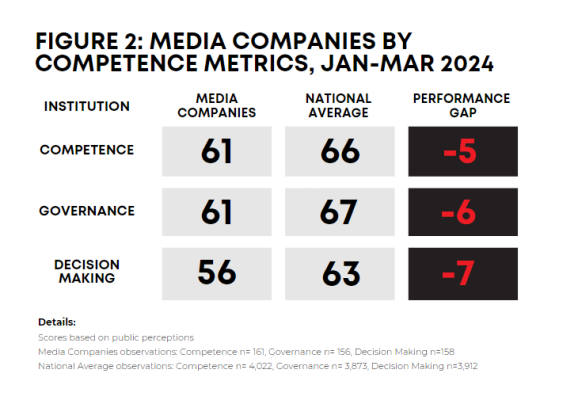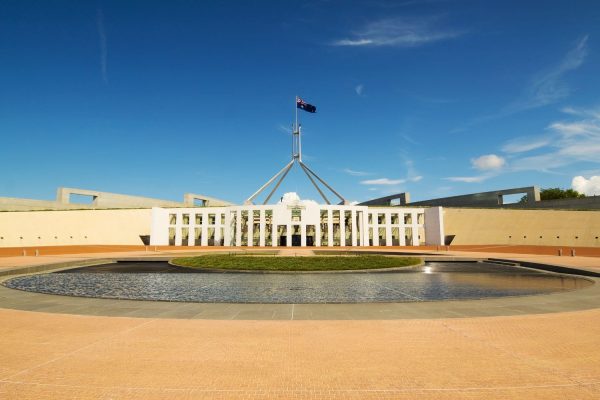Over the last 12 months, the Australian media industry has been cast into the public spotlight via the Bruce Lehmann vs Network Ten trial. Although legal proceedings are still ongoing, the public nature of these proceedings has given Australians an unprecedented insight into how the media industry procures and reports stories.
Such increased public scrutiny regarding the integrity and competence of the media industry has translated into poor public perceptions of leadership (when compared to national benchmarks), according to the Australian Leadership Index survey. Without corrective action, the media industry will continue to perform poorly on leadership perceptions.
Integrity in Australia media: A history of public transgressions
Over recent decades the Australian media industry has been plagued with transgressions that break disclosure laws, and many others that simply ‘fail the pub test’. For example, around 25 years ago, 2UE talkback radio hosts John Laws and Alan Jones were involved in a cash for comment scandal, where ABC’s Media Watch reported each host made favourable editorial comments about organisations, from whom they had received payment. Although media authorities regularly issue fines and sanctions for such integrity transgressions, the Media Watch programme has reported on numerous integrity transgressions, suggesting that these regulations and punishments have been ineffective in deterring journalists and media organisations from engaging in morally dubious, and at times illegal behaviours.
Recently, the string of legal proceedings involving Bruce Lehrmann has given Australians a closer look into how media organisations operate behind the scenes. Most notably, Chanel 7 Spotlight producer Taylor Auerbach testified that the Seven Network had paid Lehrmann $200,000 for his participation in the program, alongside a reimbursement for ‘life expenses’, which allegedly included 12 months of accommodation at a rental properly in Sydney’s northern beaches, narcotics, and even sex workers. While the Seven Network has disputed the inclusions of their agreement with Lehrmann, public cynicism around the agreement, and the Seven Networks actions in securing the interview, is high.
Public transgressions such as these have unsurprisingly led to poor public perceptions of integrity within the media industry. In fact, Australian Leadership Index data shows that the media industry is rated 3rd lowest when it comes to integrity, with a score of 54/100 in the January to March 2024 period, which is 8 points behind the national benchmark of 62/100. The recent integrity scandal, combined with a history of transgressions, means that public perceptions of media integrity have been poor for some time (as shown in Figure 1).

Media competence: Putting profit before the greater good
Although Network Ten was successful in its defence of the defamation case brought by Bruce Lehrmann (appeal pending), its actions were heavily scrutinised for prioritising corporate profit and reputation before the broader public good. While Justice Michael Lee founded in favour of Network Ten, he did not spare personal judgement, stating that the network’s actions during the Bruce Lehrmann criminal trial ‘defied common sense’.
Network Ten’s broadcast of the interview with Brittany Higgins, and the subsequent Logies speech by Lisa Wilkinson were found to undermine the criminal proceedings against Bruce Lehrmann, preventing the trial from continuing and limiting the opportunity for legal justice. Justice Michael Lee also criticised Network Ten’s legal team, labelling their advice to Ms Wilkinson and subsequent conduct after the Logies as ‘egregious’ in nature.
Actions like this cast further public doubt in the media industry’s ability to make decisions that benefit the greater good, a key pillar of media institutions. Indeed, the Australian Leadership Index data (Figure 2) shows that the public believes media organisations lack overall competence (score of 62/100 for the January to March 2024 period), governance (score of 61/100), and decision-making ability (score of 56/100) in 2024. Unsurprisingly, ratings of media competence are declining across these key metrics year-on-year, as the media’s competence is repeatedly questioned.

Improving public perceptions of the media industry
Despite its history of integrity transgressions and accusations of incompetence, the media industry continues to play an important role in Australian society. For this reason, it is paramount that public confidence in media organisations is restored.
Several actors need to come together to ensure this happens. Firstly, tighter legal regulations are required to restrict the agreements media organisations and journalists can make when sourcing stories and interviews. In their current form, these regulations are ineffective, and benefits of transgressing legal and ethical boundaries heavily outweigh any potential punishment. Secondly, the media industry must be encouraged to report without fear, as stories that reveal the truth are paramount to gaining public trust. A recent example of this included the Ben Roberts-Smith defamation trial, when Nine Entertainment published several stories exposing the SAS veteran’s behaviour, which a judge found to be ‘truthful and in the public interest’. Thirdly, investigative journalism must be encouraged as it plays an important role in holding other institutions to account for their actions. Recent investigative stories into government budgets blowouts, big banks failing to help customers facing financial difficulty, and supermarket price gouging need to be celebrated and awarded for the contributions to the public good.
Finally, the Australian Leadership Index shows that media organisations are crucial to educating the public when it comes to key issues (Figure 3). Specifically, public perceptions of the extent to which the media educates people (62/100 in the January to March 2024 period) were on par with the national average (63/100 for the same period). This indicates that Australians value the work journalists put into media reporting, and importantly, signals that there is still hope for the media industry to turn things around. Whether this occurs, however, is dependent on the industry’s ability to prioritise the greater public interest, over its own interests.





